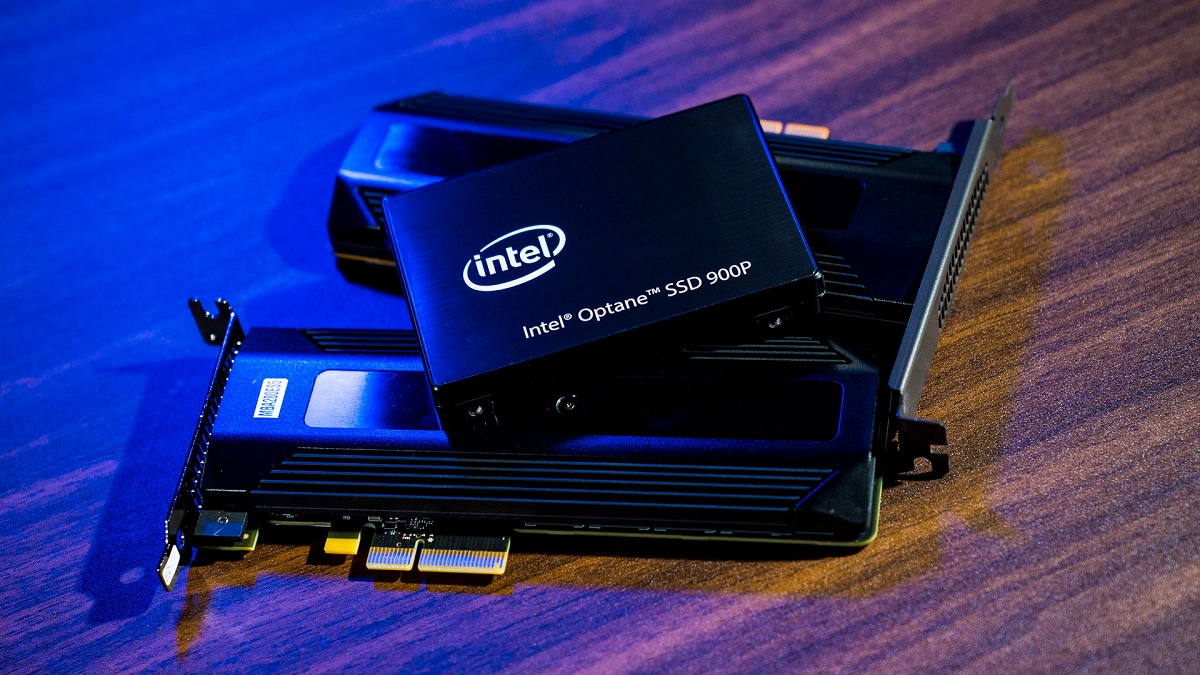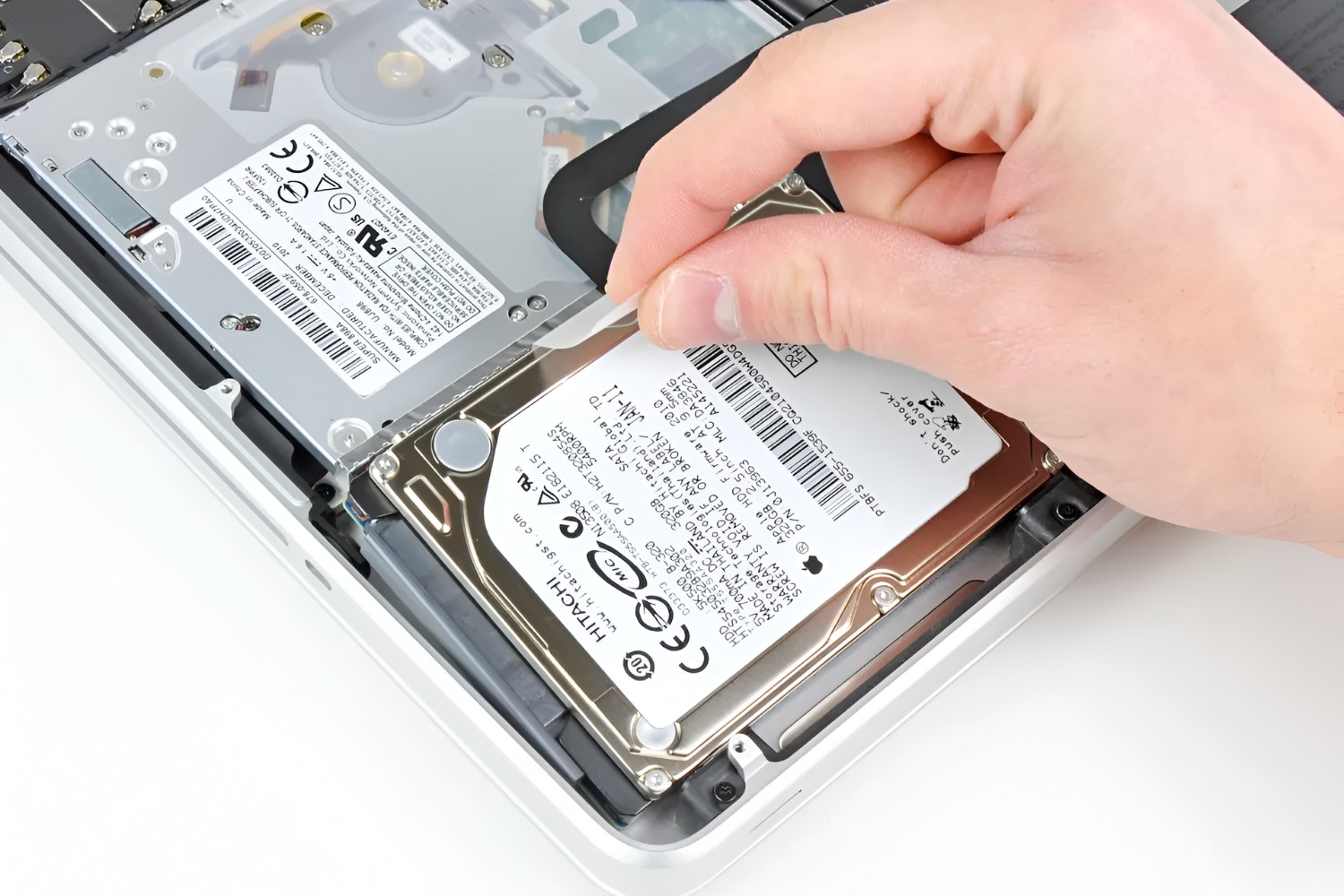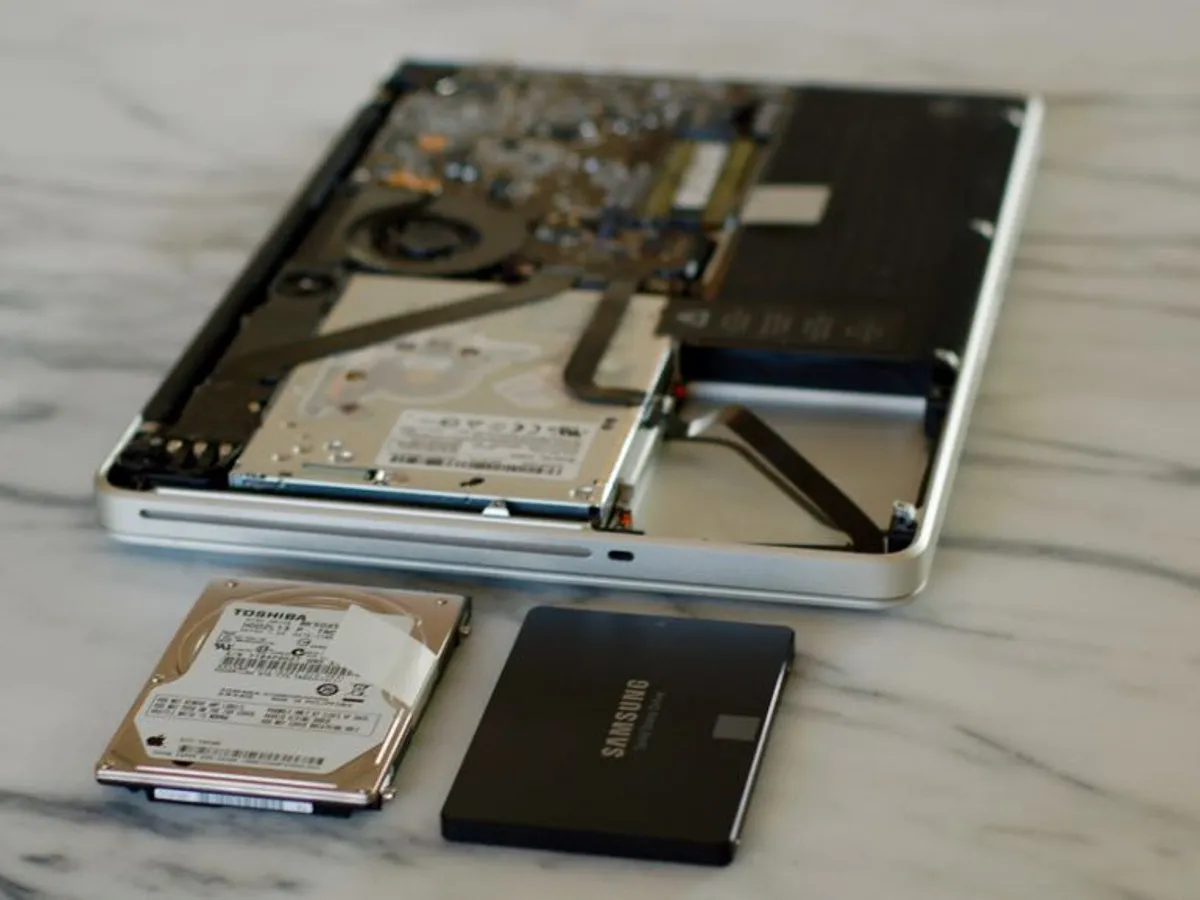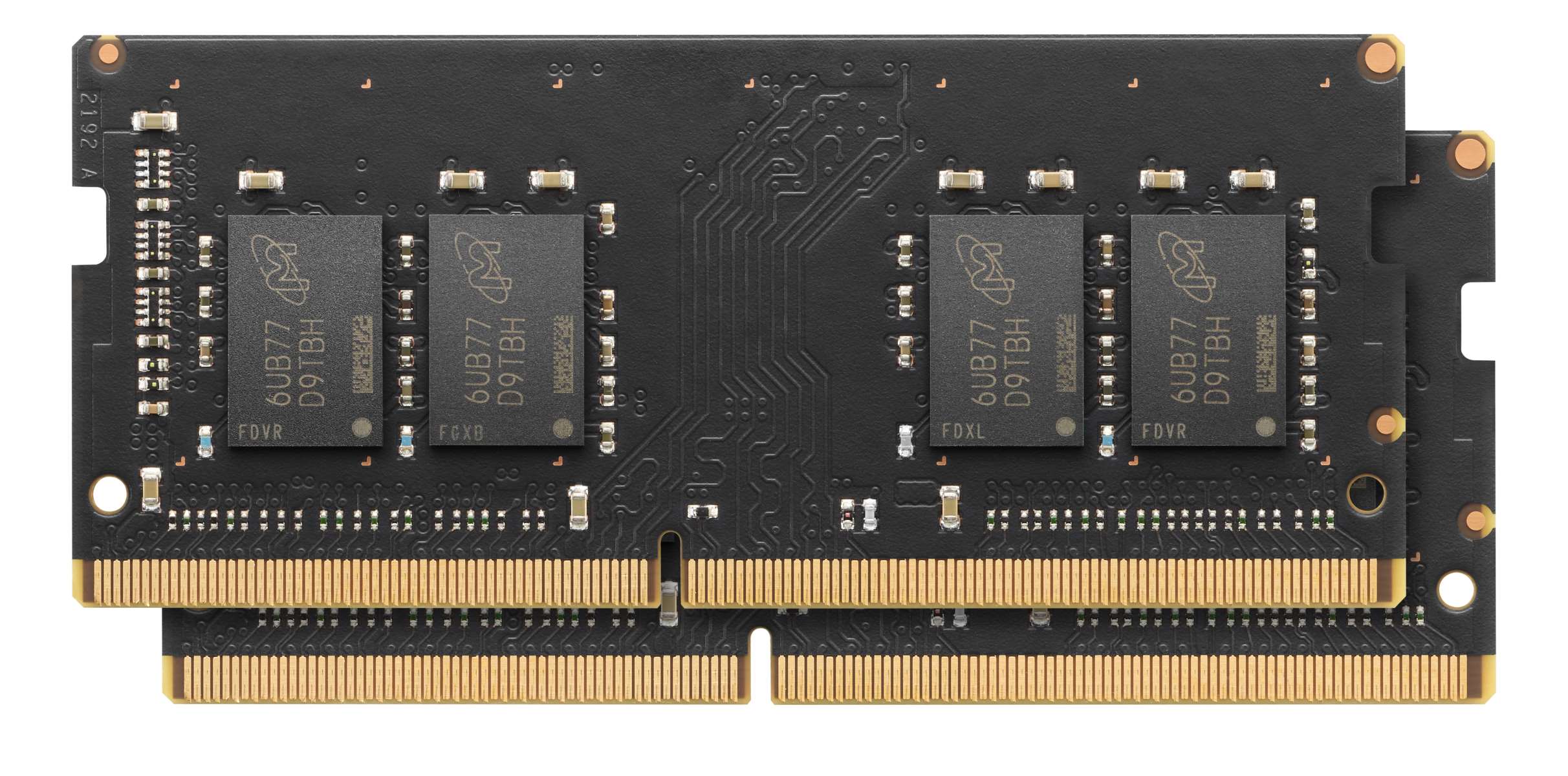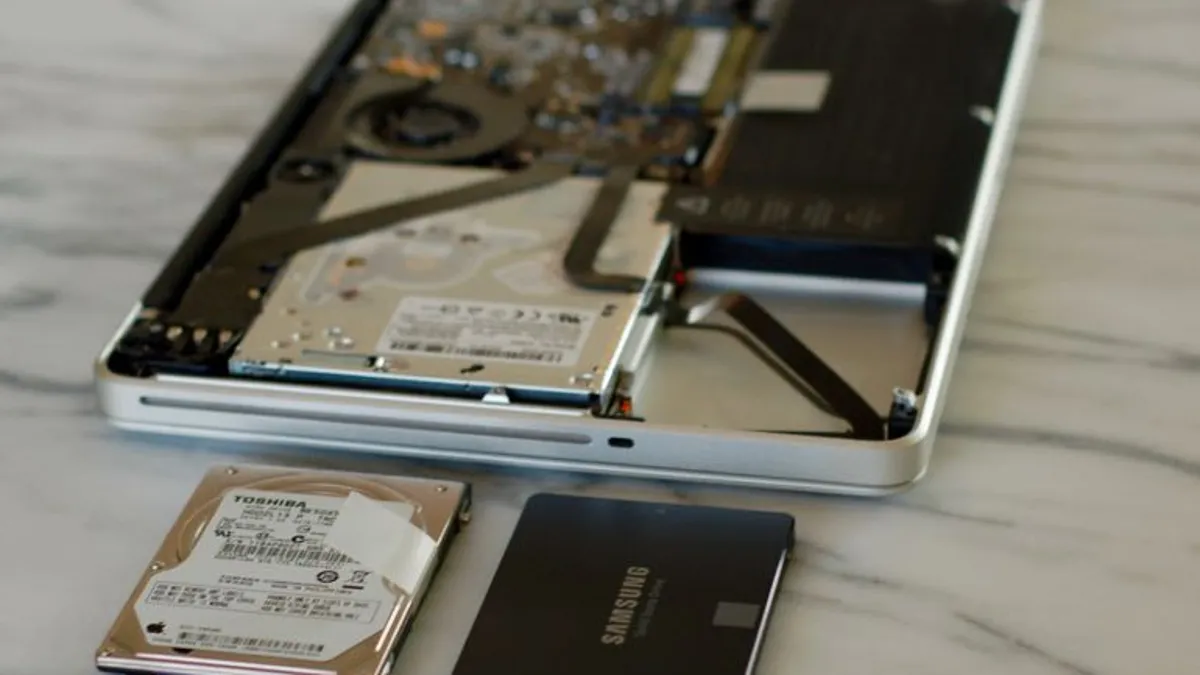Introduction
Welcome to the world of Solid State Drives (SSDs) – the future of storage technology. If you’re the proud owner of a MacBook Pro 2010, you may be wondering what kind of SSD you can install to give your old laptop newfound speed and efficiency. Upgrading to an SSD can breathe new life into your MacBook Pro by drastically improving the overall performance and reducing load times for applications and files.
In this article, we will explore the different types of SSDs that are compatible with the MacBook Pro 2010 and help you make an informed decision. We’ll discuss the two main types of SSDs available in the market – SATA SSDs and PCIe SSDs – and explain their key differences and benefits.
Furthermore, we will delve into the compatibility aspect and highlight the specific considerations you need to keep in mind before purchasing an SSD for your MacBook Pro 2010. It’s important to understand the specifications and limitations of your laptop to ensure a seamless and successful installation.
When it comes to choosing the right SSD, several factors must be taken into account. You’ll want to consider the storage capacity, speed, durability, and cost-effectiveness of the SSDs available on the market. We will provide some recommendations for trusted SSD brands that have proven compatibility and performance in MacBook Pro 2010 models.
Additionally, we’ll guide you through the installation process to make sure that you’re equipped with all the knowledge necessary to upgrade your MacBook Pro 2010’s storage. Although the process may seem daunting at first, with the right tools and instructions, it can be a relatively straightforward task.
Upgrading to an SSD offers numerous benefits. Not only will you experience a significant boost in overall performance, but you’ll also enjoy faster boot times, shorter application loading times, and improved multitasking capabilities. The enhanced reliability and durability of SSDs compared to traditional hard drives are also worth considering.
Now, let’s dive into the world of SSDs and discover the best options for your MacBook Pro 2010. We’ll help you make an informed decision and guide you through the installation process so that you can enjoy the enhanced performance and efficiency of your upgraded laptop.
SATA Solid State Drives (SSD)
SATA (Serial Advanced Technology Attachment) SSDs are a popular choice when it comes to upgrading the storage of a MacBook Pro 2010. These SSDs connect to the laptop’s SATA interface, which allows for high-speed data transfer. SATA SSDs are available in various storage capacities, ranging from 128GB to 4TB, giving you plenty of options to choose from based on your storage needs.
One of the key advantages of SATA SSDs is their widespread availability and compatibility. These drives have been around for a while, and as a result, there is a wide selection of reliable and high-quality options from reputable manufacturers. Brands such as Samsung, Crucial, and Western Digital offer SATA SSDs with excellent performance, reliability, and longevity.
When it comes to speed, SATA SSDs offer significant improvements over traditional hard drives. They have faster read and write speeds, resulting in quicker boot times and faster application loading. This speed boost can greatly enhance your overall computing experience, making multitasking smoother and reducing frustrating delays.
Another benefit of SATA SSDs is their ease of installation. Upgrading to a SATA SSD in your MacBook Pro 2010 is relatively straightforward. Most SSDs come with cloning software or provide guidance on transferring your operating system and files from the old hard drive to the new SSD. This means you can retain all your data without the hassle of reinstalling your operating system and applications.
However, it’s essential to note that the maximum speed of a SATA SSD is limited by the SATA interface itself. The MacBook Pro 2010 models typically feature SATA II or SATA III interfaces, which have maximum speeds of 3Gbps and 6Gbps, respectively. While this speed limitation may not be a significant concern for most users, if you’re seeking the absolute fastest speeds, you may want to consider PCIe SSDs, which we’ll discuss in the next section.
In summary, SATA SSDs are an excellent choice for upgrading the storage of your MacBook Pro 2010. They offer improved speed, reliability, and compatibility. With a wide range of options available, you can find a SATA SSD that meets your storage needs and budget. The relatively simple installation process makes upgrading to a SATA SSD a viable option for Mac users looking to enhance their laptop’s performance without too much hassle.
PCIe Solid State Drives (SSD)
PCIe (Peripheral Component Interconnect Express) SSDs have become increasingly popular in recent years, offering even faster data transfer speeds compared to SATA SSDs. These drives connect directly to the motherboard via the PCIe interface and can deliver exceptional performance for MacBook Pro 2010 users seeking the utmost speed and efficiency.
One of the key advantages of PCIe SSDs is their significantly higher bandwidth. Unlike SATA SSDs, which are limited by the SATA interface’s maximum speed, PCIe SSDs can leverage the higher bandwidth available through the PCIe interface, resulting in lightning-fast data transfer rates. This makes PCIe SSDs an ideal choice for power users who rely on their MacBook Pro for demanding tasks like video editing, graphic design, or gaming.
Furthermore, PCIe SSDs come in different form factors and offer varying storage capacities. Some PCIe SSDs utilize the M.2 form factor, which is a compact and space-saving design, while others may use the U.2 or PCIe card form factors. It’s important to check the compatibility of your MacBook Pro 2010 to ensure that the PCIe SSD you choose is compatible with the available PCIe slots or connectors.
When it comes to speed, PCIe SSDs outperform SATA SSDs by a wide margin. They offer incredibly fast read and write speeds, allowing for near-instantaneous application loading times and file transfers. These lightning-fast speeds can significantly improve your productivity and reduce the time spent waiting for tasks to complete.
It’s worth mentioning that while PCIe SSDs offer impressive performance, they tend to be more expensive than SATA SSDs, especially when opting for higher storage capacities. The increased cost is due to the advanced technology and higher manufacturing requirements associated with PCIe SSDs. However, if speed is of the utmost importance to you, the investment in a PCIe SSD may be worthwhile.
Another consideration with PCIe SSDs is that the installation process may be slightly more complex than with SATA SSDs. Some MacBook Pro 2010 models may require additional hardware or adapters to accommodate the PCIe SSD. Additionally, cloning your existing drive to the new PCIe SSD may require specific software or additional steps. It’s important to carefully follow the manufacturer’s instructions or seek professional assistance to ensure a successful installation.
In summary, PCIe SSDs offer unparalleled speed and performance, making them an ideal choice for power users and demanding tasks. While they may be more expensive and require a slightly more involved installation process compared to SATA SSDs, the benefits in terms of speed and efficiency can be well worth it for those seeking the ultimate performance upgrade for their MacBook Pro 2010.
Compatibility with MacBook Pro 2010
Before purchasing a new SSD for your MacBook Pro 2010, it’s crucial to ensure compatibility with your specific model. The MacBook Pro 2010 lineup consists of various models, each with its own specifications and limitations.
First and foremost, you need to identify the type of interface your MacBook Pro 2010 supports. Most MacBook Pro 2010 models are equipped with either a SATA II (3Gbps) or SATA III (6Gbps) interface. This information is crucial because it determines the maximum speed at which your SSD will perform. It’s worth noting that while a SATA III (6Gbps) SSD will work with a SATA II (3Gbps) interface, the speed will be limited to the lower interface’s maximum speed.
Next, you need to consider the physical form factor and connector compatibility. MacBook Pro 2010 models typically use 2.5-inch form factor SSDs. However, some models may require a specific connector or adapter to accommodate different SSD form factors such as M.2 or PCIe. It’s essential to research the exact specifications of your MacBook Pro 2010 model to ensure that the SSD you choose is compatible with the available slots or connectors.
Another factor to consider is the maximum storage capacity supported by your MacBook Pro 2010. While most modern SSDs offer large storage capacities, older MacBook Pro models may have limitations. The maximum supported capacity will depend on the specific model and the firmware installed on your MacBook Pro 2010. Be sure to check the official documentation from Apple or consult with the SSD manufacturer to verify the maximum supported capacity for your particular model.
Lastly, it’s important to ensure that the SSD you choose is compatible with the operating system version you have installed. While most SSDs are compatible with macOS, it’s always a good idea to verify compatibility with your specific version of macOS to avoid any unforeseen issues.
Considering the factors mentioned above, it’s vital to research and select an SSD that best suits your MacBook Pro 2010 model’s specifications and requirements. Reading user reviews, consulting the official documentation, and seeking professional advice can help ensure that the SSD you choose is compatible and fully supported by your MacBook Pro 2010.
Factors to Consider Before Choosing an SSD
When selecting an SSD for your MacBook Pro 2010, it’s important to consider several factors to ensure that you make the right choice. These factors will help determine the overall performance, compatibility, and longevity of your SSD. Let’s take a closer look at the key factors to consider:
1. Storage Capacity: Determine your specific storage needs before choosing an SSD. Consider the size of your current storage drive and estimate how much space you require for your files, applications, and operating system. SSDs are available in a wide range of capacities, from 128GB to several terabytes, so choose the capacity that suits your requirements.
2. Speed and Performance: SSDs offer superior speed compared to traditional hard drives, but not all SSDs are created equal. Look for SSDs that offer high read and write speeds to ensure faster boot times, application launches, and file transfers. Pay attention to the SSD’s interface (SATA or PCIe) and its maximum data transfer rates to choose the one that suits your performance needs.
3. Reliability and Durability: SSDs have no moving parts, making them more resistant to physical shocks and vibrations. However, different SSD brands and models may vary in terms of overall reliability and durability. Research and choose SSDs from reputable manufacturers known for their quality and dependability.
4. Price: Consider your budget when selecting an SSD. While SSDs are becoming more affordable, higher-capacity and high-performance models can still carry a higher price tag. Determine the balance between your storage needs, performance requirements, and budget to find the best SSD for your MacBook Pro 2010.
5. Compatibility: Ensure that the SSD you choose is compatible with your MacBook Pro 2010 model. Check the supported interface (SATA or PCIe), physical form factor (2.5-inch, M.2, or PCIe cards), and connector requirements of your laptop. Verify the maximum supported storage capacity and any compatibility issues with your operating system version.
6. Warranty and Support: Look for SSDs that come with a warranty as it provides peace of mind in case of any unexpected issues. Additionally, check if the manufacturer offers reliable customer support to assist you with any concerns or questions.
7. User Reviews and Ratings: Before making a final decision, read user reviews and ratings of the SSD you are considering. Real-world experiences from other MacBook Pro 2010 users can provide valuable insights into the performance, compatibility, and overall satisfaction with the chosen SSD.
By considering these factors, you can make an informed decision and select an SSD that meets your storage needs, offers the desired performance, and is compatible with your MacBook Pro 2010. Remember to weigh each factor according to your priorities and find the perfect balance for an optimal SSD upgrade experience.
Recommended SSD Brands for MacBook Pro 2010
When it comes to choosing an SSD for your MacBook Pro 2010, selecting a reliable and reputable brand is crucial for ensuring compatibility, performance, and longevity. Here are some recommended SSD brands that have proven to be excellent choices for MacBook Pro 2010 users:
1. Samsung: Samsung is a well-known brand in the SSD market, offering a wide range of high-quality SSDs with excellent performance and reliability. Their SATA SSDs, such as the Samsung 860 EVO and Samsung 870 QVO, are popular choices for MacBook Pro 2010 owners. If you’re seeking top-tier performance, Samsung’s PCIe NVMe SSDs, like the Samsung 970 EVO Plus, offer lightning-fast speeds and impressive endurance.
2. Crucial: Crucial, a brand by Micron Technology, is highly regarded for its reliable and affordable SSDs. Their MX500 SATA SSDs provide great performance and excellent value for MacBook Pro 2010 users. These SSDs offer enhanced data protection, power efficiency, and durability, making them a trusted choice for upgrading your MacBook Pro’s storage.
3. Western Digital: Western Digital is another reputable brand that offers reliable SSDs for MacBook Pro 2010. Their WD Blue and WD Black series are popular choices among users. The WD Blue SSDs provide a balance between performance and affordability, while the WD Black SSDs offer higher-end performance for demanding tasks. Western Digital is known for its quality and customer support, ensuring a positive user experience.
4. Kingston: Kingston is a brand that has gained a reputation for its reliable and high-performance SSDs. Their A2000 and KC2000 series of PCIe NVMe SSDs offer impressive speeds and storage capacities, making them suitable for MacBook Pro 2010 users seeking top-notch performance. Kingston’s SSDs come with a solid warranty and excellent customer support.
5. SanDisk: SanDisk, a division of Western Digital, is well-regarded for its solid-state drives. Their SanDisk Extreme Portable SSDs, though primarily targeted at external storage, can also be used as an internal SSD for MacBook Pro 2010 models. These SSDs provide fast data transfer speeds, rugged durability, and compact design, making them a versatile choice for upgrading your MacBook Pro’s storage.
These recommended SSD brands have a proven track record of delivering reliable performance, compatibility, and longevity for MacBook Pro 2010 models. However, it’s always advisable to review the specific models and user reviews to ensure the SSD you choose aligns with your requirements and preferences. Additionally, keep an eye on any firmware updates or compatibility announcements from the manufacturers to optimize the performance of your selected SSD.
Installation Process for SSD in MacBook Pro 2010
Upgrading the storage of your MacBook Pro 2010 with an SSD is a relatively straightforward process. While it may seem intimidating at first, following the steps below will help you successfully install the SSD:
1. Gather the necessary tools: Before beginning the installation, ensure you have the proper tools. You will typically need a small Phillips screwdriver, an external hard drive or USB drive for creating a backup, and a small container to keep track of the screws.
2. Back up your data: It’s essential to back up all important data from your existing hard drive before starting the installation process. You can use Time Machine or any other backup software to create a complete backup of your files, applications, and system settings.
3. Power off your MacBook Pro: Shut down your MacBook Pro and disconnect all cables and peripherals. This includes the power adapter, external hard drives, and any other devices connected to your laptop.
4. Remove the bottom case: On the bottom of your MacBook Pro, locate the screws that secure the bottom case. Use the Phillips screwdriver to unscrew and remove the case. Set aside the screws in a safe place for reassembly.
5. Locate the old hard drive: Once the bottom case is removed, you will see the existing hard drive. It is usually placed in a bracket or enclosure. Carefully disconnect any cables or connectors attached to the hard drive.
6. Remove the old hard drive: Unscrew the screws that secure the old hard drive to the bracket or enclosure. Gently remove the hard drive from its slot, taking care not to damage any surrounding components.
7. Install the SSD: Place the SSD in the same slot where the old hard drive was. Align it properly and secure it in place using the screws from the previous step. Connect any necessary cables or connectors to the SSD.
8. Reassemble your MacBook Pro: Carefully place the bottom case back onto your MacBook Pro and screw it in place using the saved screws. Ensure that all the edges are aligned properly for a secure fit.
9. Power on and initialize the SSD: Connect your MacBook Pro to the power adapter and turn it on. Hold down the Command + R keys to enter macOS Recovery mode. From here, you can use Disk Utility to initialize and format your new SSD, preparing it for use.
10. Restore your data: Once the SSD is initialized, you can restore your data from the backup you created earlier. Use Time Machine or your backup software of choice to restore your files, applications, and system settings to your new SSD.
Following these steps will guide you through the installation process for an SSD in your MacBook Pro 2010. However, it’s important to note that the process may vary slightly depending on the specific model of your MacBook Pro. Consult the official documentation from Apple or seek professional assistance if you encounter any difficulties or have specific questions regarding your installation.
Benefits of Upgrading to a Solid State Drive
Upgrading your MacBook Pro 2010 with a solid-state drive (SSD) offers numerous benefits that can significantly enhance your overall computing experience. Let’s explore some of the key advantages of upgrading to an SSD:
1. Improved Performance: SSDs are faster than traditional hard drives, providing significantly faster boot times and application loading speeds. Your MacBook Pro will be more responsive, allowing you to open programs and access files quickly. Tasks such as launching apps, copying files, and multitasking will become smoother and more seamless.
2. Faster File Transfers: With an SSD, file transfers and data access become much faster. Copying, moving, and saving files will require less time, enabling you to work more efficiently. Whether you’re working with large multimedia files or performing regular backups, the speed boost from an SSD can save you valuable time.
3. Energy Efficiency: SSDs consume less power compared to traditional hard drives. With improved energy efficiency, your MacBook Pro’s battery life may be extended, allowing you to use your laptop for longer periods without needing to recharge. This benefit is particularly useful when you’re on the go or working in locations where power outlets may not be readily available.
4. Increased Durability: Unlike mechanical hard drives, SSDs have no moving parts. This makes them more resistant to shocks, vibration, and physical damage. Upgrading to an SSD means your MacBook Pro’s storage is less susceptible to failure due to accidental drops or bumps, making it a more reliable option for storing your valuable data.
5. Noise Reduction: The absence of moving parts in an SSD translates to a quieter operation. Without the spinning platters and read/write heads found in traditional hard drives, SSDs produce virtually no noise during their functioning. This creates a more peaceful and distraction-free working environment.
6. Enhanced System Stability: SSDs offer improved system stability by reducing the risk of disk fragmentation. Unlike traditional hard drives that can suffer from fragmentation, which slows down system performance over time, SSDs are not susceptible to this issue. This means your MacBook Pro will maintain its speed and overall performance even after prolonged use.
7. Compact and Lightweight Design: SSDs have a compact form factor and are significantly lighter compared to mechanical hard drives. This contributes to a slimmer and lighter MacBook Pro, making it easier to carry and travel with your laptop while still enjoying ample storage space.
8. Increased Longevity: SSDs have a longer lifespan compared to traditional hard drives. With no moving parts, they are less prone to mechanical failure and are built to handle extensive read and write operations. By upgrading to an SSD, you can extend the lifespan of your MacBook Pro and enjoy reliable storage for years to come.
Overall, upgrading to an SSD provides substantial benefits for your MacBook Pro 2010. The improved performance, faster file transfers, enhanced energy efficiency, reliability, and other advantages make it a worthwhile investment. Experience the power and speed of an SSD and unlock your MacBook Pro’s full potential.
Conclusion
Upgrading the storage of your MacBook Pro 2010 with a solid-state drive (SSD) can breathe new life into your laptop, providing significant performance improvements and enhancing your overall computing experience. Whether you choose a SATA SSD or a PCIe SSD, the benefits are undeniable.
By opting for an SSD, you can enjoy faster boot times, quicker application loading, and seamless multitasking. The increased speed and responsiveness of an SSD will save you time and frustration, allowing you to work more efficiently and smoothly.
Furthermore, SSDs offer increased durability, energy efficiency, and system stability compared to traditional hard drives. The absence of moving parts makes SSDs less susceptible to physical damage, and their lower power consumption extends the battery life of your MacBook Pro.
When selecting an SSD, it’s essential to consider factors such as storage capacity, performance, compatibility, and brand reputation. By choosing reputable SSD brands like Samsung, Crucial, Western Digital, Kingston, or SanDisk, you can ensure compatibility, reliability, and excellent customer support.
The installation process for an SSD in your MacBook Pro 2010 is relatively straightforward, and with the right tools and guidance, you can successfully upgrade your storage without hassle. Back up your data, follow the step-by-step instructions, and enjoy the improved speed and efficiency of your laptop with the new SSD.
In conclusion, upgrading to a solid-state drive is a worthy investment for MacBook Pro 2010 users seeking to boost their laptop’s performance and enjoy a more seamless computing experience. The benefits of an SSD, including improved speed, energy efficiency, reliability, and durability, make it an essential upgrade for those who want to optimize their MacBook Pro’s capabilities.
Embrace the future of storage technology and upgrade your MacBook Pro 2010 with an SSD – it’s an investment that will enhance your productivity, save you time, and provide a more enjoyable computing experience.









